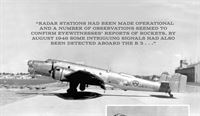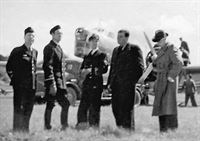Фотографии
-
Blondie was originally on strength with F 11 Wing at Nykoping, but was later transferred to F 1 Wing at Vasteras before moving again to F 8 Wing at Barkarby, near Stockholm. The aircraft wore minimal markings, bearing only its name on the forward fuselage beneath the cockpit and a standard Flygvapnet roundel either side of the rear fuselage. It was later given the fin code number “50”, when based at Bromma.
Самолёты на фотографии: Junkers Ju.86 - Германия - 1934
-
During 1936-58 some 56 Junkers Ju 86Ks saw service with Flygvapnet, which designated the type B 3 (B for Bombflygplan - bomber aircraft), 16 of which were licence-produced by Saab. One example, serial 150, seen here, was used by Sweden’s FOA and FRA agencies to investigate the 1946 spate of “ghost rocket” sightings.
Самолёты на фотографии: Junkers Ju.86 - Германия - 1934
-
The aircraft used for SIGINT/ELINT missions in 1946 was B 3A (Ju 86K-4) serial 150, named Blondie, powered by a pair of 820 h.p. Nohab My III (licence-built Bristol Pegasus III) radial engines. The cylindrical excrescence on the underside of the fuselage just aft of the mainwheels is the radome for its crucial AN/APS-15 navigation radar.
Самолёты на фотографии: Junkers Ju.86 - Германия - 1934
-
A poor-quality but extremely rare photograph of Blondie’s crew in 1946, with the B 3A in the background. From left to right: Stig Lindberg, pilot; Ulf Mide, observer; Sven-Uno Palmqvist (radio operator); unknown, and SIGINT/ELINT specialist Sture Risberg.
Самолёты на фотографии: Junkers Ju.86 - Германия - 1934
-
Самолёты на фотографии: Junkers Ju.86 - Германия - 1934
Статьи
- -
- A.Tincopa - Marked by misfortune
- C.Gibson - Perfect 10
- C.Habermehl, R.Hopkins III - Stratojets in Blighty
- D.Stringer - The Viscount comes to America (1)
- L.Andersson - Sweden's ghost rocket
- N.Stroud - Bamboo birds & other rare species
- N.Stroud - Vikings in Africa /The John Stroud Archive/
- N.Yakubovich - Shcherbakov's forgotten workhorse
- P.Davidson - Off the Beaten Track...
- P.Jarrett - The world's first aeronautical exhibition
- R.Flude, G.Alegi - The Rome-Tokyo express. The Regia Aeronautica's 1942 route-proving flight to Japan /The Axis's wartime air links/ (1)
- R.Pegram - Imperial Airways. The 1930s: a cause for concern?
- T.Eeles - Brute force & innovation




